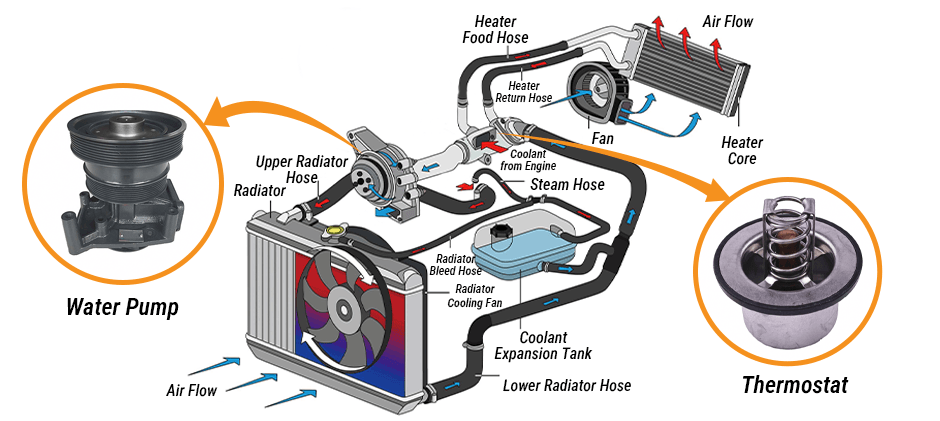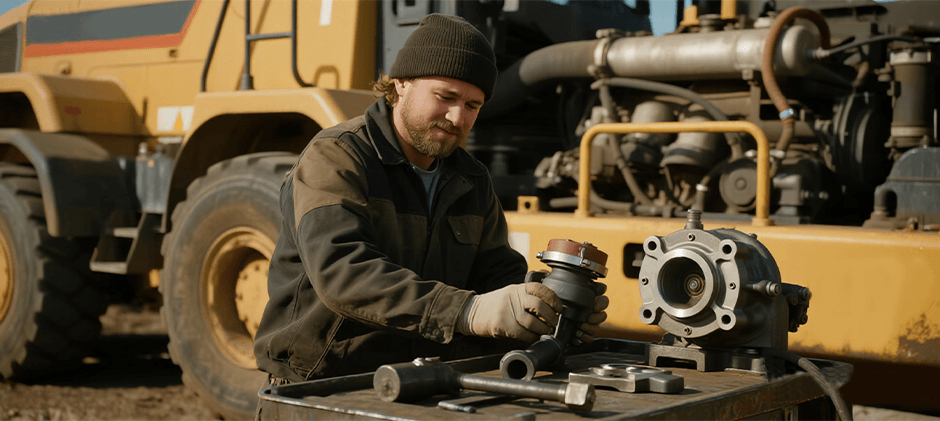The water pump and thermostat work together in the cooling system to ensure that the equipment has enough coolant circulating so that the engine does not easily exceed the maximum temperature it can withstand, 220 degrees Fahrenheit.
They work together to maintain the good operation of the equipment cooling system, but sometimes, when cooling system problems occur, it is difficult to distinguish which one of them has a problem. Therefore, through this article, you will learn how to clearly distinguish which one of them fault when a problem comes, how they work together, etc., to help you make a quick judgment and replace the broken parts in time.
What Do the Water Pump and Thermostat Do?
To properly diagnose cooling system issues, it’s important to understand the individual roles of the water pump and thermostat—and more importantly, how they work together.
The Water Pump: The Heart of the Cooling System
The water pump is the driving force behind coolant circulation. Powered by a belt, it uses an impeller to move coolant through the engine and radiator continuously. Hot coolant is drawn from the engine block, sent to the radiator to cool, and then pushed back into the engine. Without the pump, the coolant won’t move, and the engine will overheat.
The Thermostat: The Temperature Regulator
The thermostat acts like a smart valve. When the engine is cold, it stays closed to help the engine warm up quickly. Once the engine reaches optimal temperature (around 180–200°F / 82–93°C), the thermostat opens, allowing coolant to flow to the radiator. This ensures the engine stays within the right temperature range.
How Do They Work Together?
Think of the water pump and thermostat as a coordinated team: the pump moves coolant, while the thermostat controls when and where it flows.
- Cold Start: Thermostat is closed → Pump circulates coolant only within the engine → Engine warms up quickly
- Warm Engine: Thermostat opens → Pump now moves coolant through the radiator → Heat is removed
- Regulation: Thermostat opens/closes as needed → Pump keeps circulating → Engine temperature remains stable
If either one fails, the system breaks:
- A bad pump can’t move coolant, even if the thermostat is open
- A stuck thermostat blocks flow, even if the pump is working fine
This balance is why both parts are often inspected (and sometimes replaced together) during cooling system service. Their teamwork is what keeps your engine safe under pressure.
Signs of A Bad Water Pump or Thermostat
A failing cooling system will almost always give you warning signs. First, recognizing the phenomena of water pump and thermostat failure respectively, and then distinguishing them to better understand the principle of replacing parts. I will help you summarize a quick distinction table at the end to facilitate your confirmation!
Common Water Pump Failure Symptoms
- Coolant Leaks: Look for green, orange, or pink fluid under the engine. Leaks from the weep hole or gasket mean the pump’s internal seal is failing and needs immediate replacement.
- Grinding or Whining Noises: Strange noises from the front of the engine often point to a worn bearing. If ignored, the pump could seize and cause more damage.
- Wobbly Pulley: If the pump’s pulley feels loose when moved by hand, the bearing has likely failed. This can lead to belt damage and accessory failure.
- Engine Overheating: A damaged impeller or seized bearing stops coolant flow, causing the engine to overheat quickly. Shut off the engine if you see the temperature spike.
Common Thermostat Failure Symptoms
A bad Thermostat can be more subtle, but its symptoms are just as serious.
- Overheating After Warm-Up (Stuck Closed): This is the most common failure mode. The engine warms up to its normal temperature, but then it just keeps getting hotter. This happens because the Thermostat is stuck closed and is not allowing coolant to get to the radiator.
- Engine Running Too Cold (Stuck Open): If your temperature gauge never seems to reach the middle of the normal range, your Thermostat is likely stuck open. This allows coolant to circulate constantly, preventing the engine from ever reaching its optimal temperature. This leads to poor fuel economy, increased emissions, and long-term engine wear.
- Erratic Temperature Changes: Does your temperature gauge swing wildly from cool to hot? This often indicates a Thermostat that is sticking and then suddenly popping open.
Two-Step to Diagnosing the Thermostat
While observing symptoms is a great start, a couple of simple, hands-on tests can often give you a definitive answer without expensive tools. These tests help you move from a strong suspicion to a confirmed diagnosis.
WARNING: Always perform these tests on a completely cool engine to avoid severe burns from hot coolant.
Test 1: The Thermostat “Hot Water” Test
This classic mechanic’s trick directly tests if your thermostat is opening and closing at the correct temperature.
- Locate and Remove the Thermostat: You will need to drain some coolant from the system to access the thermostat housing. Once removed, take note of the temperature stamped on it (usually between 180°F and 200°F).
- Prepare the Test: Place the cool thermostat in a pot of water on a stove. If you have a cooking thermometer, place it in the water as well.
- Observe and Heat: As you heat the water, watch the thermostat closely. It should be fully closed when the water is cold.
- The Verdict: As the water temperature approaches the temperature stamped on the thermostat, you should see its valve begin to open. If it fails to open at all, it’s stuck closed. If it was already open when you put it in the cool water, it’s stuck open. This test gives you a clear pass/fail result.
Test 2: The Water Pump “Coolant Flow” Check
This test checks if the water pump is actually circulating coolant through the system.
- Remove the Radiator Cap: With the engine completely cold, remove the radiator cap.
- Start the Engine: Turn the engine on and let it idle.
- Look for Flow: Carefully look into the radiator neck. As the engine warms up and the thermostat opens, you should see the coolant beginning to flow or circulate. If the coolant remains perfectly still even as the engine temperature climbs, it’s a strong sign the water pump’s impeller is not moving fluid.
- Squeeze the Hose: Another method is to carefully squeeze the upper radiator hose. When the engine is cool, it will be soft. As the engine reaches operating temperature and the thermostat opens, you should feel a surge of hot fluid and pressure through the hose. If the engine is overheating but the hose remains cool and limp, no coolant is circulating, pointing directly to a failed water pump.
By performing these simple checks, you can be much more confident in your diagnosis before you begin the repair.
Bad Water Pump vs Thermostat Symptoms
Use the following table to distinguish whether the problem lies with the water pump or the thermostat of your cooling system, and conduct a quick diagnosis.
| Symptom | Water Pump | Thermostat |
|---|---|---|
| Engine Overheats Quickly | Unlikely, unless it seized on startup. | Very Likely (Stuck Closed) |
| Engine Runs Too Cold | Not a symptom. | Very Likely (Stuck Open) |
| Visible Coolant Leak at Front | Very Likely (Failed Seals/Gasket) | Possible, but less common. |
| Grinding/Whining Noise | Very Likely (Failing Bearing) | Not a symptom. |
| Temperature Gauge Swings Wildly | Unlikely. | Very Likely (Sticking Valve) |
Telling the difference between a bad water pump and a failing thermostat comes down to where and when the symptoms appear in your engine’s behavior. A failing thermostat often causes predictable temperature irregularities—either the engine takes too long to warm up or overheats in a steady, gradual way. You’ll also notice changes shortly after startup. In contrast, a water pump failure usually shows up under load or after extended driving, and the symptoms are more mechanical in nature, such as coolant leaks, bearing noises, or belt slippage.
Another key difference: if you notice the heater stops blowing warm air while the engine overheats, it’s more likely a thermostat issue. If the coolant level is dropping with no visible crack in the radiator, suspect the water pump’s weep hole or gasket. A pressure test or inspection of coolant flow with the radiator cap removed (only when the engine is cold) can also help pinpoint whether coolant is circulating properly—a job the water pump should be handling.
Should You Replace the Thermostat and Water Pump Together?
According to the experience of our customers and most maintenance veterans, the thermostat usually needs to be replaced when the water pump is replaced. Generally speaking, the price of the thermostat is not expensive, and replacing it can prevent the problem from occurring again for a long time in the future.
The Top 4 Reasons to Replace Them Together
Replacing a water pump already involves major labor—here’s why it’s smart to replace the thermostat at the same time:
-
Shared Labor
Since the system is already drained and disassembled for the water pump, replacing the thermostat takes just a few extra minutes. Doing it later means repeating the entire process—and paying for it twice.
-
Similar Lifespan
Both parts endure the same heat, pressure, and coolant exposure. If the pump is worn out, chances are the thermostat isn’t far behind.
-
Avoid Misdiagnosis
A stuck thermostat can cause overheating just like a failed pump. Replacing both eliminates guesswork and ensures the cooling issue is fully resolved.
-
Minimize Downtime
Swapping both parts now helps prevent another unexpected breakdown later. A small upfront cost can save you big on labor, coolant, and lost productivity
The above are 4 specific reasons why they need to be replaced. You can choose whether to replace them at the same time based on the condition of your equipment.
Conclusion
Your cooling system is non-negotiable. Learning to recognize and differentiate between the symptoms of a malfunctioning water pump or thermostat is key to protecting your equipment. Replacing both components at the same time is not an upsell; it’s the smartest, most cost-effective maintenance strategy. It saves you money, prevents future downtime, and gives you confidence in your machine’s reliability.
When that time comes, choosing the best water pump and Thermostat is crucial. At FridayParts.com, we are a leading aftermarket parts supplier specializing in high-quality parts at affordable prices. Our vast inventory ensures we have the right components for a wide range of heavy equipment brands. Don’t compromise on your cooling system. Get the reliable parts you need from us and keep your engine running cool.


